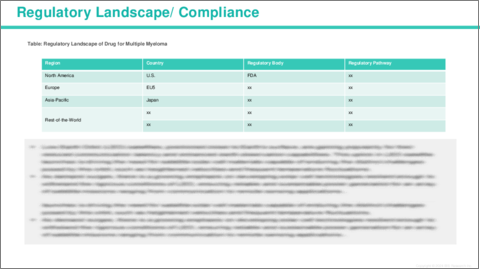|
|
市場調査レポート
商品コード
1764709
多発性骨髄腫市場- 世界および地域別分析:国別・地域別 - 分析と予測(2025年~2035年)Multiple Myeloma Market - A Global and Regional Analysis: Focus on Country and Region - Analysis and Forecast, 2025-2035 |
||||||
カスタマイズ可能
|
|||||||
| 多発性骨髄腫市場- 世界および地域別分析:国別・地域別 - 分析と予測(2025年~2035年) |
|
出版日: 2025年07月09日
発行: BIS Research
ページ情報: 英文 100 Pages
納期: 1~5営業日
|
全表示
- 概要
- 図表
- 目次
世界の多発性骨髄腫市場、分析と予測:2025年~2035年
多発性骨髄腫は、抗体を産生する骨髄の形質細胞に発症するがんの一種です。
多発性骨髄腫では、これらの形質細胞ががん化して制御不能に増殖し、正常な血液細胞を混雑させます。その結果、骨が弱くなり、貧血、腎臓障害、免疫力の低下などの合併症を引き起こします。この病気の主な特徴の一つは、M蛋白と呼ばれる異常な蛋白質の産生であり、この蛋白質は血液中や尿中に蓄積し、様々な臓器、特に腎臓に障害を引き起こす可能性があります。
多発性骨髄腫の症状には、しばしば骨痛、疲労、再発性感染症、原因不明の体重減少などがあります。診断は通常、血液検査、尿検査、骨髄生検、X線やMRIなどの画像診断によって行われます。多発性骨髄腫は現在のところ不治の病ですが、化学療法、免疫療法、CAR T細胞療法などの治療法の進歩により、患者さんの転帰が改善し、症状の管理が向上し、生存期間が延長しました。しかし、患者はしばしば、病気の管理と再発予防のために継続的な治療を必要とします。
多発性骨髄腫市場の主な促進要因の一つは、革新的な標的治療に対する需要の増加です。多発性骨髄腫の分子的・遺伝的メカニズムの理解が深まるにつれ、再発・難治性多発性骨髄腫患者特有のニーズに対応できる治療に対するニーズが高まっています。CAR T細胞療法、二重特異性抗体、モノクローナル抗体などの免疫療法は、従来の治療法に比べ、より効果的で、個別化された、毒性の少ない治療選択肢を提供することから、大きな支持を集めています。これらの治療は生存率を向上させるだけでなく、患者のQOLを高めるため、このような先進的な治療に対する需要を煽っています。さらに、多発性骨髄腫の世界の罹患率が特に高齢化とともに上昇する中、疾患を管理し余命を延ばすための新たな治療選択肢に対するニーズはより緊急性を増しており、多発性骨髄腫市場の成長をさらに後押ししています。
多発性骨髄腫市場の成長にもかかわらず、いくつかの課題がその進展を阻害し続けています。主な課題の一つは、治療費の高さです。CAR T細胞療法、二重特異性抗体、モノクローナル抗体などの先進的な治療法は非常に高価であり、1回の治療に数十万米ドルかかることも少なくないです。このことは、多くの患者、特に低所得者や開発途上地域ではヘルスケアシステムがこれらの治療を十分にサポートできない可能性がある患者にとって、アクセスの大きな障壁となります。
さらに、治療抵抗性も大きな課題です。多発性骨髄腫患者はしばしば再発を経験し、初期治療に対する耐性が時間の経過とともに生じます。このことは、患者さんが複数回の治療を必要とし、各回で異なる治療やより強力な治療が必要になる可能性があることを意味します。薬剤耐性の開発により既存の治療法の有効性が低下するため、この問題を克服する新しい治療法の必要性が生じています。
さらに、化学療法や免疫療法を含む積極的な治療による副作用は、患者のQOLに大きな影響を与えます。多くの患者は、疲労、骨痛、吐き気、感染リスクなどの重篤な副作用を経験し、治療レジメンを複雑にし、患者のコンプライアンスを低下させます。
最後に、多発性骨髄腫は進行した段階で診断されることが多いため、早期発見が依然として課題となっています。明確な初期症状がないため、ヘルスケア提供者が病気が進行する前に発見することが困難であり、予後不良につながる可能性があります。このような課題から、より効果的で費用のかからない治療法、診断技術の向上、および治療期間中の患者のより良い管理戦略の必要性が浮き彫りになっています。
世界の多発性骨髄腫市場は競争が激しく、Johnson & Johnson(Janssen Pharmaceuticals, Inc.)、Sanofi S.A.、AbbVie Inc.、Bristol-Myers Squibb Company、Takeda Pharmaceutical Company Limited、Pfizer Inc.、Karyopharm Therapeutics Inc.、Cellectar Biosciences, Inc.、BioLineRx Ltd.などの主要企業が技術革新と市場成長を牽引しています。これらの企業は、免疫療法、CAR T細胞治療、二重特異性抗体、プロテアソーム阻害剤などの新規治療法の開発で最先端を走っており、患者の予後を大幅に改善しています。研究開発への戦略的投資、製品ポートフォリオの拡大、最先端治療への世界のアクセス拡大を通じて、これらの業界リーダーは多発性骨髄腫治療の未来を形成し、市場のダイナミックな成長に貢献しています。加えて、個別化医療や併用療法への取り組みが治療の展望を変え、再発/難治性多発性骨髄腫患者により的を絞った効果的な選択肢を提供しています。
市場セグメンテーション:
セグメンテーション1:地域別
- 北米
- 欧州
- アジア太平洋
世界の多発性骨髄腫市場は、治療パラダイムを再構築し多発性骨髄腫市場の成長を牽引する新たな動向に後押しされ、大きな変革期を迎えています。最も注目すべき動向の1つは、CAR T細胞療法、二重特異性抗体、モノクローナル抗体などの免疫療法へのシフトであり、再発または難治性の多発性骨髄腫患者に対して、より標的を絞った効果的な治療を提供しています。これらの治療法は、従来の化学療法と比較して高い寛解率と長期生存率をもたらし、この疾患の管理方法に革命をもたらしています。
もう一つの重要な傾向は、個別化医療への注目の高まりです。個別化医療とは、患者の遺伝的体質や疾患の特徴に基づいて治療法を調整するものです。このアプローチにより、治療がより効果的かつ正確になり、副作用が減少し、患者の転帰が改善されます。遺伝子検査やバイオマーカーを用いた治療法の決定は今後さらに広まり、治療の最適化が進むと予想されます。
また、免疫調節薬(IMiD)、プロテアソーム阻害薬、標的治療薬などを併用し、治療効果を高める併用療法の台頭も加速しています。これらのレジメンは、特に単剤治療で薬剤耐性を獲得した患者に対して、より包括的なアプローチを提供します。
さらに、リキッドバイオプシー、次世代シークエンシング、バイオマーカープロファイリングなどの診断技術の進歩により、多発性骨髄腫の早期発見が可能となり、タイムリーな介入と患者の予後改善につながっています。早期診断が普及するにつれて、早期治療の市場は拡大し続けるでしょう。
アジア太平洋やラテンアメリカなどの地域では、ヘルスケアへのアクセスが改善し、医療インフラが整備されつつあるため、先進的な治療に対する需要が高まっています。多発性骨髄腫治療における継続的な臨床研究と技術革新に加え、これらの動向は多発性骨髄腫市場の将来を形成し、新たな成長機会をもたらしています。
当レポートでは、世界の多発性骨髄腫市場について調査し、市場の概要とともに、国・地域別の動向、および市場に参入する企業のプロファイルなどを提供しています。
目次
エグゼクティブサマリー
第1章 世界の多発性骨髄腫市場:業界展望
- イントロダクション
- 市場動向
- 規制の枠組み
- 疫学分析
- 臨床試験分析
- 市場力学
第2章 世界の多発性骨髄腫市場(地域別)、2023年~2035年
- 北米
- 欧州
- アジア太平洋
第3章 世界の多発性骨髄腫市場:競合情勢と企業プロファイル
- 主要戦略と開発
- 合併と買収
- 相乗効果のある活動
- 事業拡大と資金調達
- 製品の発売と承認
- その他の活動
- 企業プロファイル
- Sanofi S.A.
- Karyopharm Therapeutics Inc.
- AbbVie Inc.
- Takeda Pharmaceutical Company Limited
- Bristol-Myers Squibb Company
- Pfizer Inc.
- Cellectar Biosciences, Inc.
- BioLineRx Ltd.
- Aduro Biotech, Inc.
- Johnson & Johnson (Janssen Pharmaceuticals, Inc.)
第4章 調査手法
List of Figures
- Figure: Global Multiple Myeloma Market (by Region), $Billion, 2024 and 2035
- Figure: Global Multiple Myeloma Market Key Trends, Analysis
List of Tables
- Table: Global Multiple Myeloma Market Dynamics, Impact Analysis
- Table: Global Multiple Myeloma Market (by Region), $Billion, 2024-2035
Global Multiple Myeloma Market, Analysis and Forecast: 2025-2035
Multiple Myeloma is a type of cancer that develops in the plasma cells of the bone marrow, which are responsible for producing antibodies. In multiple myeloma, these plasma cells become cancerous and proliferate uncontrollably, crowding out normal blood cells. This leads to several complications, including weakened bones, anemia, kidney damage, and a weakened immune system. One of the key hallmarks of the disease is the production of abnormal proteins called M-proteins, which can accumulate in the blood or urine and cause damage to various organs, particularly the kidneys.
Symptoms of multiple myeloma often include bone pain, fatigue, recurrent infections, and unexplained weight loss. Diagnosis is typically made through blood tests, urine tests, bone marrow biopsy, and imaging such as X-rays or MRI. While multiple myeloma is currently incurable, advancements in treatment, including chemotherapy, immunotherapy, and CAR T-cell therapy, have improved patient outcomes, allowing for better management of symptoms and extended survival. However, patients often require continuous treatment to manage the disease and prevent relapse.
One of the key drivers of the multiple myeloma market is the increasing demand for innovative and targeted therapies. As the understanding of the disease's molecular and genetic mechanisms deepens, there is a growing need for treatments that can address the specific needs of patients with relapsed and refractory multiple myeloma. Immunotherapies, such as CAR T-cell therapies, bispecific antibodies, and monoclonal antibodies, are gaining significant traction as they offer more effective, personalized, and less toxic treatment options compared to traditional therapies. These therapies not only improve survival rates but also enhance the quality of life for patients, fuelling the demand for such advanced treatments. Additionally, as the global incidence of multiple myeloma rises particularly with an aging population the need for novel treatment options to manage the disease and extend life expectancy is becoming more urgent, further propelling multiple myeloma market growth.
Despite the growth of the Multiple Myeloma market, several challenges continue to hinder its progress. One of the primary challenges is the high cost of treatment. Advanced therapies such as CAR T-cell therapy, bispecific antibodies, and monoclonal antibodies can be extremely expensive, often costing hundreds of thousands of dollars per treatment. This poses a significant barrier to access for many patients, particularly in low-income or developing regions where healthcare systems may not be able to fully support these therapies.
Additionally, treatment resistance is another major challenge. Multiple myeloma patients often experience relapses, and the disease can become resistant to initial therapies over time. This means that patients may need multiple rounds of treatment, with each round potentially involving different or more intensive therapies. The development of drug resistance reduces the effectiveness of existing treatments, creating a need for new therapies that can overcome this issue.
Furthermore, side effects from aggressive treatments, including chemotherapy and immunotherapy, can significantly impact a patient's quality of life. Many patients experience severe side effects such as fatigue, bone pain, nausea, and infection risk, which can complicate treatment regimens and reduce patient compliance.
Finally, early detection remains a challenge, as multiple myeloma is often diagnosed at an advanced stage. The absence of clear early symptoms makes it difficult for healthcare providers to catch the disease before it progresses, which can lead to a poorer prognosis. These challenges underscore the need for more effective, less costly treatments, improved diagnostic techniques, and better management strategies for patients throughout their treatment journey.
The global Multiple Myeloma market is highly competitive, with several leading companies driving innovation and market growth, such as Johnson & Johnson (Janssen Pharmaceuticals, Inc.), Sanofi S.A., AbbVie Inc., Bristol-Myers Squibb Company, Takeda Pharmaceutical Company Limited, Pfizer Inc., Karyopharm Therapeutics Inc., Cellectar Biosciences, Inc., and BioLineRx Ltd. These companies are at the forefront of developing novel therapies including immunotherapies, CAR T-cell treatments, bispecific antibodies, and proteasome inhibitors, which are significantly improving patient outcomes. Through strategic investments in research and development (R&D), expanding product portfolios, and increasing global access to cutting-edge treatments, these industry leaders are shaping the future of multiple myeloma care and contributing to the dynamic growth of the market. Additionally, their efforts in personalized medicine and combination therapies are transforming the treatment landscape, providing more targeted and effective options for relapsed/refractory multiple myeloma patients.
Multiple Myeloma Market Segmentation:
Segmentation 1: by Region
- North America
- Europe
- Asia-Pacific
The global Multiple Myeloma market is undergoing significant transformation, fueled by emerging trends that are reshaping treatment paradigms and driving multiple myeloma market growth. One of the most notable trends is the shift towards immunotherapy, including CAR T-cell therapy, bispecific antibodies, and monoclonal antibodies, which offer more targeted and effective treatments for patients with relapsed or refractory multiple myeloma. These therapies are revolutionizing the way the disease is managed, providing higher rates of remission and long-term survival compared to traditional chemotherapy.
Another key trend is the increasing focus on personalized medicine, where therapies are tailored based on a patient's genetic makeup and disease characteristics. This approach ensures that treatments are more effective and precise, reducing side effects and improving patient outcomes. The use of genetic testing and biomarkers to guide treatment decisions is expected to become more widespread, further optimizing care.
The rise of combination therapies is also gaining momentum, with the use of immunomodulatory drugs (IMiDs), proteasome inhibitors, and targeted therapies in combination to enhance treatment efficacy. These regimens offer a more comprehensive approach, particularly for patients who have developed drug resistance to single-agent treatments.
Additionally, advancements in diagnostic technologies such as liquid biopsy, next-generation sequencing, and biomarker profiling are enabling earlier detection of multiple myeloma, leading to timely interventions and better patient outcomes. As early diagnosis becomes more prevalent, the market for early-stage therapies will continue to expand.
Finally, global expansion into emerging markets is another driving force, as improving healthcare access and the growing healthcare infrastructure in regions such as Asia-Pacific and Latin America lead to increased demand for advanced treatments. These trends, alongside continued clinical research and innovation in the treatment of multiple myeloma, are shaping the future of the multiple myeloma market and providing new opportunities for growth.
Table of Contents
Executive Summary
Scope and Definition
Market/Product Definition
Inclusion and Exclusion
Key Questions Answered
Analysis and Forecast Note
1. Global Multiple Myeloma Market: Industry Outlook
- 1.1 Introduction
- 1.2 Market Trends
- 1.3 Regulatory Framework
- 1.4 Epidemiology Analysis
- 1.5 Clinical Trial Analysis
- 1.6 Market Dynamics
- 1.6.1 Impact Analysis
- 1.6.2 Market Drivers
- 1.6.3 Market Challenges
- 1.6.4 Market Opportunities
2. Global Multiple Myeloma Market (Region), ($Billion), 2023-2035
- 2.1 North America
- 2.1.1 Key Findings
- 2.1.2 Market Dynamics
- 2.1.3 Market Sizing and Forecast
- 2.1.3.1 North America Multiple Myeloma Market, by Country
- 2.1.3.1.1 U.S.
- 2.1.3.1 North America Multiple Myeloma Market, by Country
- 2.2 Europe
- 2.2.1 Key Findings
- 2.2.2 Market Dynamics
- 2.2.3 Market Sizing and Forecast
- 2.2.3.1 Europe Multiple Myeloma Market, by Country
- 2.2.3.1.1 Germany
- 2.2.3.1.2 U.K.
- 2.2.3.1.3 France
- 2.2.3.1.4 Italy
- 2.2.3.1 Europe Multiple Myeloma Market, by Country
- 2.3 Asia Pacific
- 2.3.1 Key Findings
- 2.3.2 Market Dynamics
- 2.3.3 Market Sizing and Forecast
- 2.3.3.1 Asia Pacific Multiple Myeloma Market, by Country
- 2.3.3.1.1 China
- 2.3.3.1.2 Japan
- 2.3.3.1 Asia Pacific Multiple Myeloma Market, by Country
3. Global Multiple Myeloma Market: Competitive Landscape and Company Profiles
- 3.1 Key Strategies and Development
- 3.1.1 Mergers and Acquisitions
- 3.1.2 Synergistic Activities
- 3.1.3 Business Expansions and Funding
- 3.1.4 Product Launches and Approvals
- 3.1.5 Other Activities
- 3.2 Company Profiles
- 3.2.1 Sanofi S.A.
- 3.2.1.1 Overview
- 3.2.1.2 Top Products / Product Portfolio
- 3.2.1.3 Top Competitors
- 3.2.1.4 Target Customers/End-Users
- 3.2.1.5 Key Personnel
- 3.2.1.6 Analyst View
- 3.2.2 Karyopharm Therapeutics Inc.
- 3.2.2.1 Overview
- 3.2.2.2 Top Products / Product Portfolio
- 3.2.2.3 Top Competitors
- 3.2.2.4 Target Customers/End-Users
- 3.2.2.5 Key Personnel
- 3.2.2.6 Analyst View
- 3.2.3 AbbVie Inc.
- 3.2.3.1 Overview
- 3.2.3.2 Top Products / Product Portfolio
- 3.2.3.3 Top Competitors
- 3.2.3.4 Target Customers/End-Users
- 3.2.3.5 Key Personnel
- 3.2.3.6 Analyst View
- 3.2.4 Takeda Pharmaceutical Company Limited
- 3.2.4.1 Overview
- 3.2.4.2 Top Products / Product Portfolio
- 3.2.4.3 Top Competitors
- 3.2.4.4 Target Customers/End-Users
- 3.2.4.5 Key Personnel
- 3.2.4.6 Analyst View
- 3.2.5 Bristol-Myers Squibb Company
- 3.2.5.1 Overview
- 3.2.5.2 Top Products / Product Portfolio
- 3.2.5.3 Top Competitors
- 3.2.5.4 Target Customers/End-Users
- 3.2.5.5 Key Personnel
- 3.2.5.6 Analyst View
- 3.2.6 Pfizer Inc.
- 3.2.6.1 Overview
- 3.2.6.2 Top Products / Product Portfolio
- 3.2.6.3 Top Competitors
- 3.2.6.4 Target Customers/End-Users
- 3.2.6.5 Key Personnel
- 3.2.6.6 Analyst View
- 3.2.7 Cellectar Biosciences, Inc.
- 3.2.7.1 Overview
- 3.2.7.2 Top Products / Product Portfolio
- 3.2.7.3 Top Competitors
- 3.2.7.4 Target Customers/End-Users
- 3.2.7.5 Key Personnel
- 3.2.7.6 Analyst View
- 3.2.8 BioLineRx Ltd.
- 3.2.8.1 Overview
- 3.2.8.2 Top Products / Product Portfolio
- 3.2.8.3 Top Competitors
- 3.2.8.4 Target Customers/End-Users
- 3.2.8.5 Key Personnel
- 3.2.8.6 Analyst View
- 3.2.9 Aduro Biotech, Inc.
- 3.2.9.1 Overview
- 3.2.9.2 Top Products / Product Portfolio
- 3.2.9.3 Top Competitors
- 3.2.9.4 Target Customers/End-Users
- 3.2.9.5 Key Personnel
- 3.2.9.6 Analyst View
- 3.2.10 Johnson & Johnson (Janssen Pharmaceuticals, Inc.)
- 3.2.10.1 Overview
- 3.2.10.2 Top Products / Product Portfolio
- 3.2.10.3 Top Competitors
- 3.2.10.4 Target Customers/End-Users
- 3.2.10.5 Key Personnel
- 3.2.10.6 Analyst View
- 3.2.1 Sanofi S.A.






